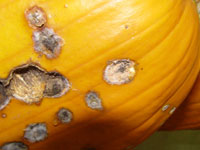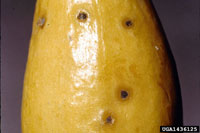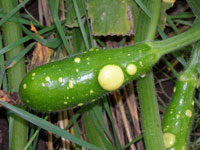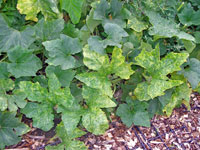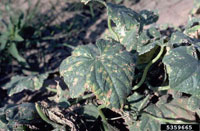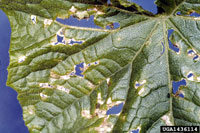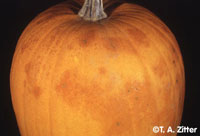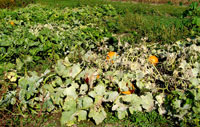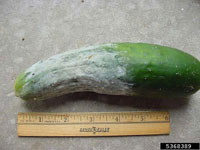Extension > Garden > Diagnose a problem > What's wrong with my plant? > Vegetable > Winter Squash and Pumpkins > Spots on fruit
Winter Squash and Pumpkins > Fruit > Spots on fruit
1 of 6
Anthracnose
Colletotrichum obriculare
- Circular sunken dark spots on fruit up to ½” across
- Salmon colored spores form in the center of fruit spots when wet
- Irregular brown leaf spots
- Commonly appears mid to late season
- Also common on melons and cucumber
- More information on Anthracnose
2 of 6
Scab
Cladosporium cucumerinum
- Cucumber, summer squash, zucchini, and pumpkin have sunken fruit spots are covered with greenish black velvety fungal growth
- Winter squash have raised corky areas around fruit infections, internal rot varies depending on resistance of variety
- Irregular gray leaf spot with a yellow halo
- Center of leaf spot falls out, leaves look shot holed or ragged
- Watermelon is very resistant
- More information on Scab
3 of 6
Virus
Squash mosaic, cucumber mosaic, watermelon mosaic
- Fruit may have unusual color patterns, blotches or rings but are not rotten
- Fruit are often deformed and distorted
- Irregular, blotchy to wavy patterns of yellows and greens on leaves
- Plants may be stunted
- Leaves may be distorted (sometimes fern-like), wrinkled, and curled
- More information on Virus
4 of 6
Angular Leaf Spot
Pseudomonas syringae pv. Lachrymans
- Water soaked to tan small circular spots on fruit
- Leaves develop small, angular, brown or straw-colored spots with a yellow halo
- Leaf spots dry and drop out, leaving irregularly shaped holes in the leaves
- Sticky drops of whitish liquid for on the underside of the leaf when wet, dry to a crust when dry
- More information on Angular Leaf Spot
5 of 6
Powdery Mildew
Podosphaera xanthii
- Fruit may be blotchy or have sunscald
- Initially pale yellow spots develop on the oldest leaves
- White to gray powdery felt in spots, blotches or complete covering of leaves
- Lesions develop on underside of leaves, or on shaded leaves first
- Older leaves infected first
- Severe infection can cause leaves and vines to wither and die
- More information on Powdery Mildew
6 of 6
Phytophthora Blight
Phytophthora capsici
- Fruit develop soft, water-soaked lesions which expand to large sections of the fruit
- Infected fruit are soft, easily punctured and often collapse
- Infected fruit are covered with white fungal growth
- Large irregular brown spots on leaves
- Stem and leaf petiole lesions are light to dark brown, water soaked and irregular
- The entire plant may collapse if root and crown rot occurs
- More information on Phytophthora Blight




